Direct Lake Guidance
With the release of Tabular Editor 3.22.0, we have added support for Direct Lake on OneLake in addition to Direct Lake on SQL. This article provides a short overview of the differences between these two modes, and how they compare to other storage modes available in Power BI semantic models.
Storage mode overview
The following table summarizes the storage modes available in Power BI semantic models:
| Storage Mode | Description | Recommended Use Cases |
|---|---|---|
| Import | Data is imported into the semantic model and stored in the model's in-memory cache (VertiPaq). | When you need fast query performance and can afford to refresh the data periodically. |
| DirectQuery | Data is queried directly from the source at query time, without being imported into the model. Supports various sources, such as SQL, KQL and even other semantic models. | When you need real-time data access or when the data volume is too large to fit in memory. |
| Dual | A hybrid mode where the engine can choose between returning the imported data or delegating to DirectQuery, depending on the query context. | When your model contains a mix of DirectQuery and Import tables (for example when using aggregations), and you have tables that are related to both. |
| Direct Lake on OneLake | Utilizes the Delta Parquet story format to quickly swap the data into semantic model memory when needed. | When your data is already available as tables or materialized views in a Fabric Warehouse or Lakehouse. |
| Direct Lake on SQL | Older version of Direct Lake which utilizes the SQL Analytics Endpoint of Fabric Warehouses or Lakehouses. | Not recommended for new development (use Direct Lake on OneLake instead). |
Note
It is also possible to create tables that contain a mix of partitions in Import and DirectQuery mode (also known as "hybrid tables"). This is commonly done on large fact tables that require incremental refresh while some data is queried directly from the source. See this article for more information.
Direct Lake on OneLake vs. Direct Lake on SQL
Direct Lake on OneLake was introduced in March 2025 as an alternative to Direct Lake on SQL. With Direct Lake on OneLake, there is no dependency on the SQL endpoint and no fallback to DirectQuery mode. This also means that the usual restrictions that apply to DirectQuery models do not apply to Direct Lake on OneLake models.
However, as with Direct Lake on SQL, there are still some limitations that do apply. The most important limitations are listed below. See the link for a full list of limitations:
- Calculated columns on Direct Lake tables cannot reference columns that are sourced from OneLake.
- Calculated tables on Direct Lake models cannot refer columns on Direct Lake tables that are sourced from OneLake.
One possible workaround for the above limitation, is to create a composite model by combining Direct Lake tables with Import tables. This is allowed with Direct Lake on OneLake, but not with Direct Lake on SQL. In this case, you would typically use Import mode for smaller dimension tables, where you may need to add custom groupings, which calculated columns are ideal for, while keeping the larger fact tables in Direct Lake mode.
Alternatively, ensure that your source contains the columns it needs. If you add columns through a view, please note that the view must be materialized in the Fabric Warehouse or Lakehouse, as Direct Lake on OneLake does not support non-materialized views.
Collation
When using Direct Lake on OneLake, the collation of the model is the same as for an Import model, which is case-insensitive by default.
For a Direct Lake on SQL model, the collation is case-insensitive for queries that do not fallback to DirectQuery. If the query does fallback, the collation depends on the collation of the source. For a Fabric Warehouse, the collation might be case-sensitive, in which case you should specify a case-sensitive collation on the model.
Note
You cannot change the collation of a model once the metadata has been deployed to Analysis Services / Power BI. As such, if you plan to use Direct Lake on SQL with a case-sensitive Fabric Warehouse, you must set the collation on the model metadata before it's deployed:
- Create a new model in Tabular Editor 3 (File > New > Model...)
- Uncheck "Use workspace database"
- Set the Collation property on the model to
Latin1_General_100_BIN2_UTF8 - Save the model (Ctrl+S).
- Now, open the model from the file you just saved. When prompted to connect to a workspace database, choose "Yes".
With this approach, the model metadata gets deployed with the correct collation from the start, and you can then add tables in Direct Lake on SQL mode without running into collation issues.
Table Import Wizard
To add Direct Lake tables using Tabular Editor 3's Table Import Wizard, choose Microsoft Fabric Lakehouse, Microsoft Fabric Warehouse, Microsoft Fabric SQL Database or Microsoft Fabric Mirrored Database as the source:
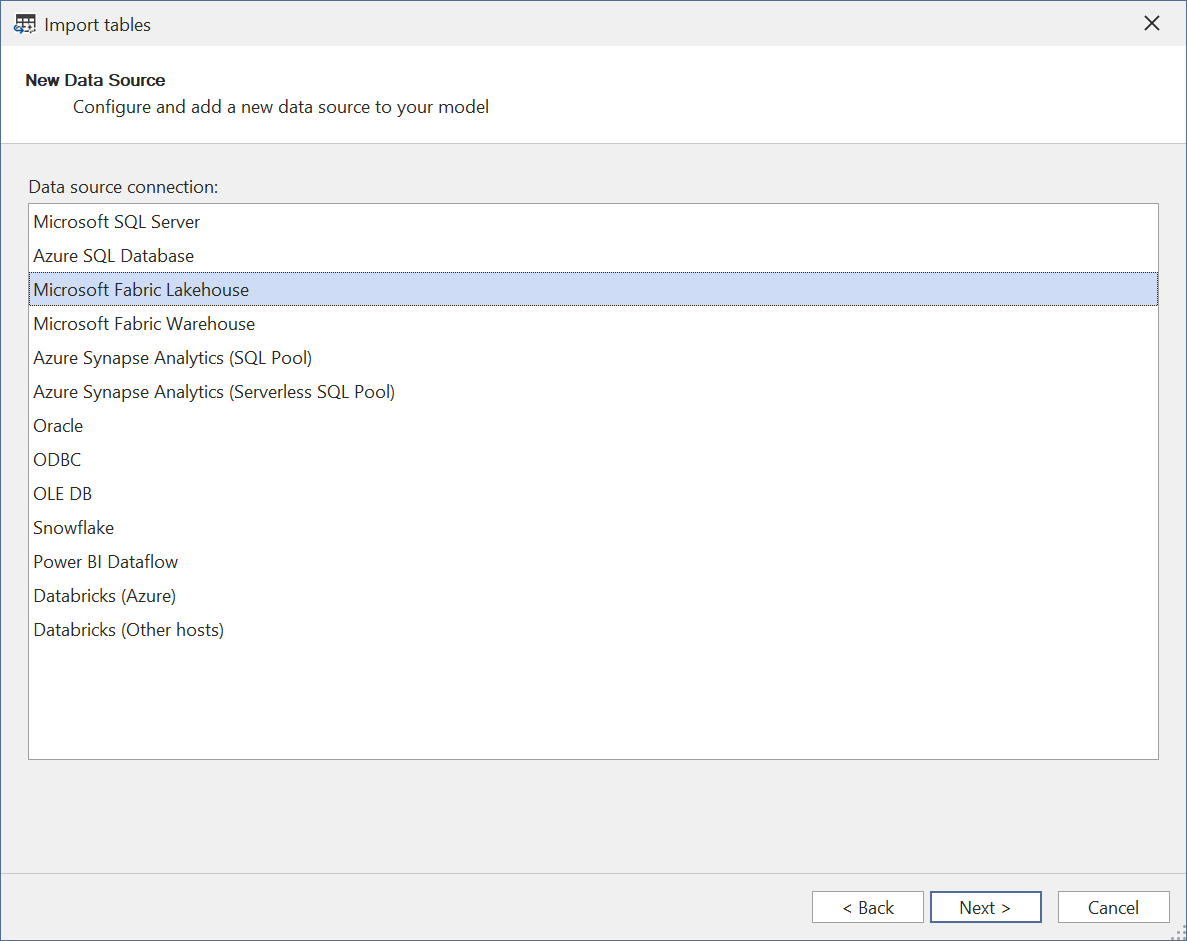
After signing in, you will be presented with a list of all available Fabric Lakehouses/Warehouses in workspaces you have access to. Select the one you want to connect to and hit OK:
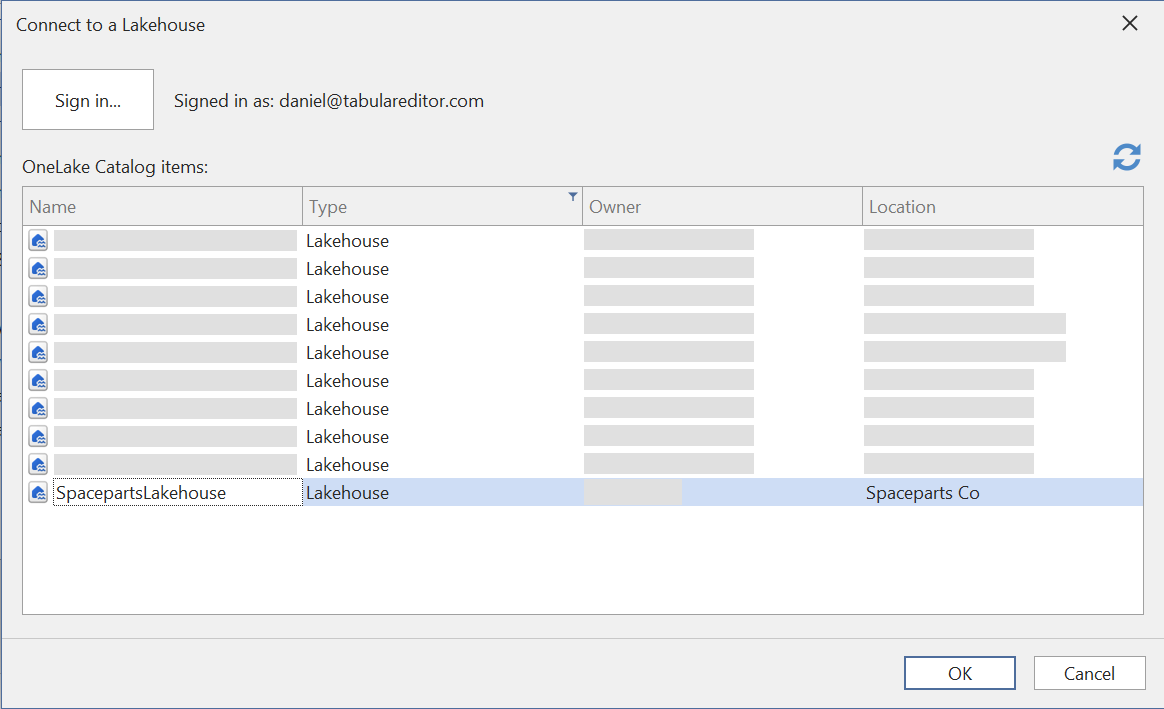
Unless you want to specify a custom SQL query, or configure the tables for DirectQuery mode, simply hit Next to select the tables from a list of tables/views in the source:
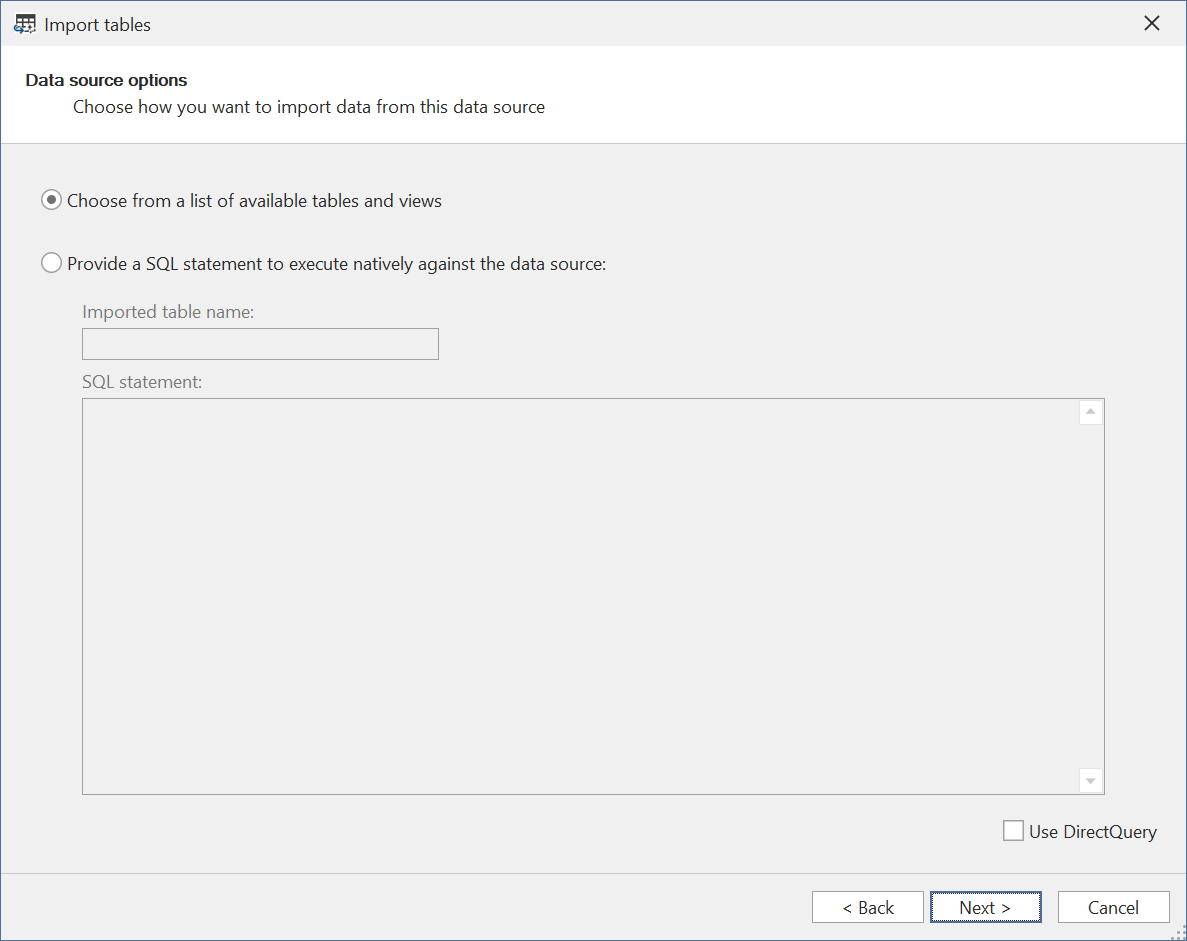
Select the tables/views you wish to import. Note that non-materialized views are not supported in Direct Lake on OneLake mode. Attempting to add such a view to the model will result in an error upon saving the model metadata.
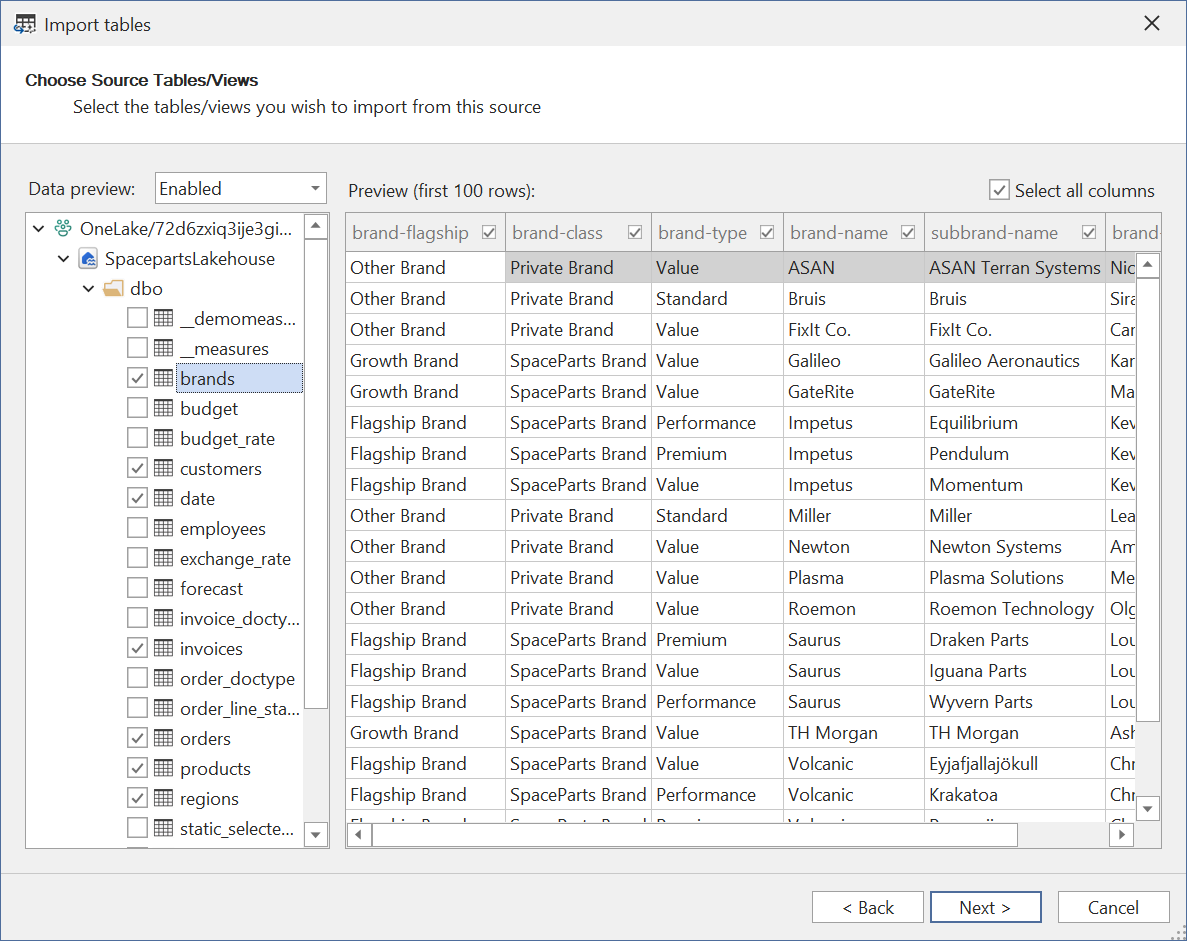
On the last page, choose which mode you want the table partition to be configured with:

The choices are:
- Direct Lake on OneLake
- Direct Lake on SQL
- Import (M)
Note
If you're working on a model that already contains tables, one or more of the choices mentioned above may not be available, if the model does not support combining tables in different storage modes. For example, if the model contains a table in Direct Lake on SQL mode, you cannot add tables in other modes.
Power Query (M) expressions
This section contains a more technical description on how the TOM objects and properties need to be configured, in case you want to manually set up tables for Direct Lake mode without using the Table Import Wizard.
Direct Lake on OneLake
To manually set up a table for Direct Lake on OneLake mode, you need to do the following:
- Create Shared Expression: Direct Lake tables use "Entity" partitions, which much reference a Shared Expression in the model. Start out by creating this shared expression, if you don't have it already. Name it
DatabaseQuery:

- Configure Shared Expression: Set the Kind property of the expression you created in step 1 to "M", and set the Expression* property to the following M query, replacing the IDs in the URL for your Fabric workspace and Lakehouse/Warehouse:
let
Source = AzureStorage.DataLake("https://onelake.dfs.fabric.microsoft.com/<workspace-id>/<resource-id>", [HierarchicalNavigation=true])
in
Source
- Create Table and Entity Partition: Create a new table in the model (Alt+5), then expand the table partitions in the TOM Explorer, and create new Entity Partition:
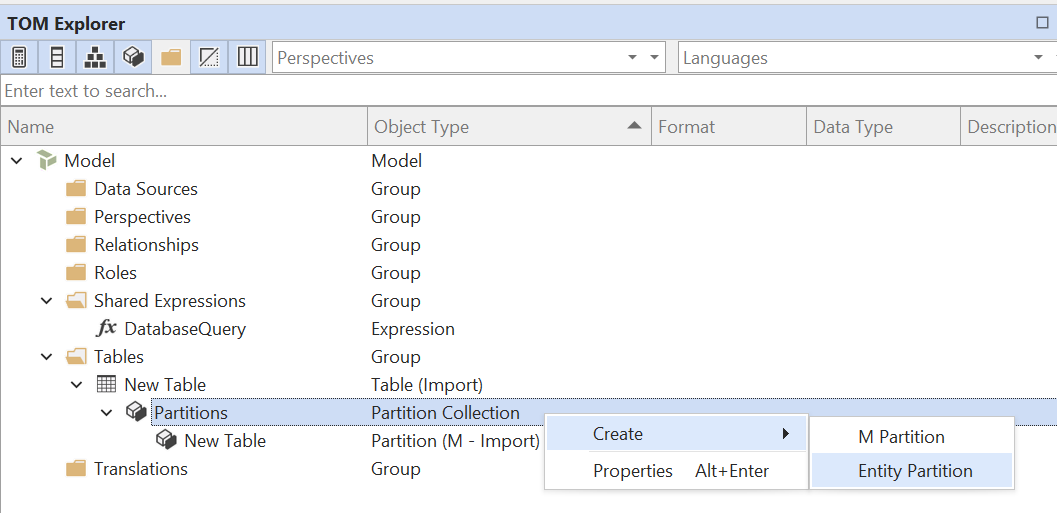
Delete the regular import partition that was automatically created when you created the table.
- Configure Entity Partition: Set the following properties on the Entity Partition:
| Property | Value |
|---|---|
| Name | (Recommended) Set to the same name as the table |
| Entity Name | (Required) Set to the name of the table in the Lakehouse/Warehouse |
| Expression Source | (Required) Set to the Shared Expression you created in step 1, typically DatabaseQuery |
| Mode | (Required) DirectLake |
| Schema Name | (Optional) Set to the schema name in the Lakehouse/Warehouse, if applicable. If not set, the default schema will be used. |
The final result should look like this:
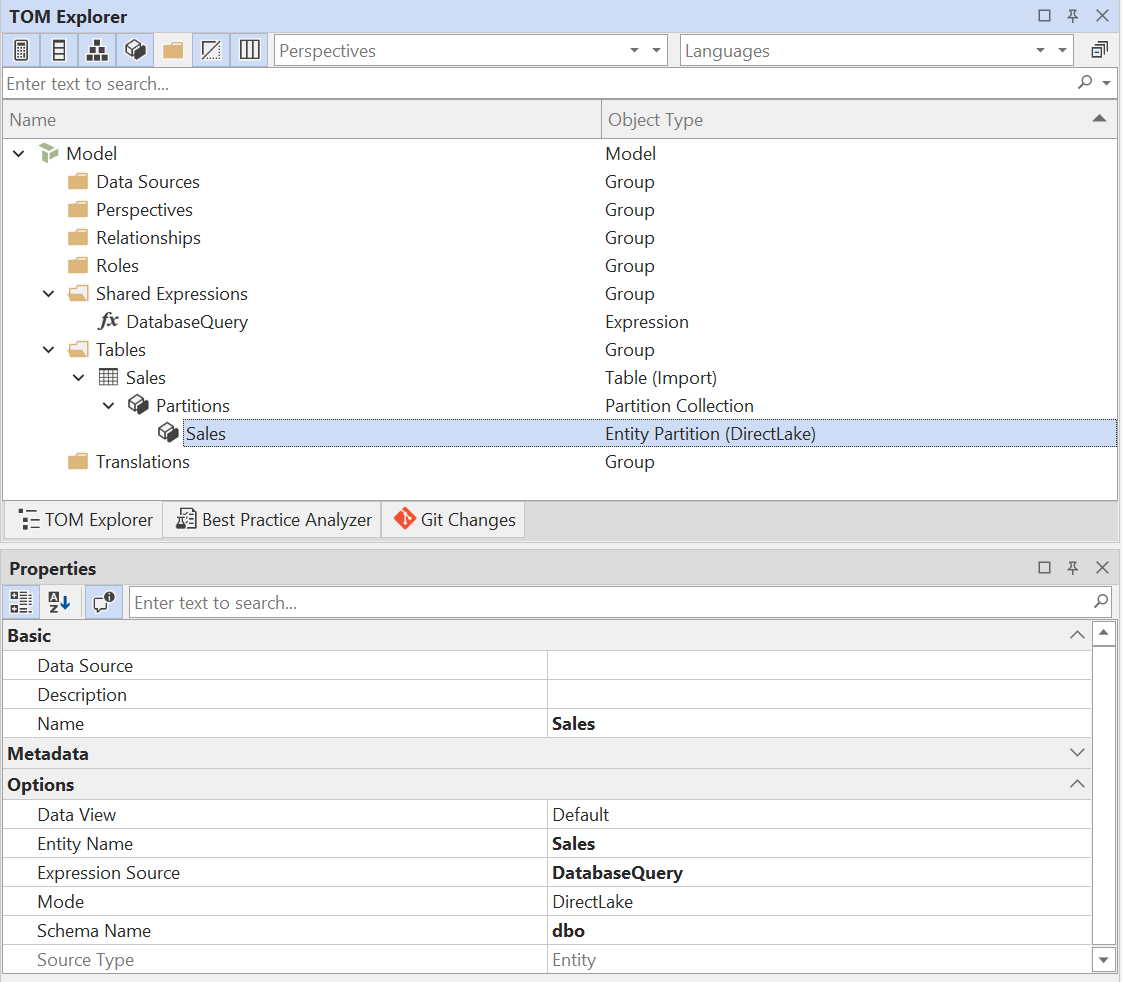
- Update column metadata: At this stage, you should be able to use Tabular Editor's Update Table Schema feature to update the column metadata for the table. This will automatically retrieve the column names and data types from the Lakehouse/Warehouse:
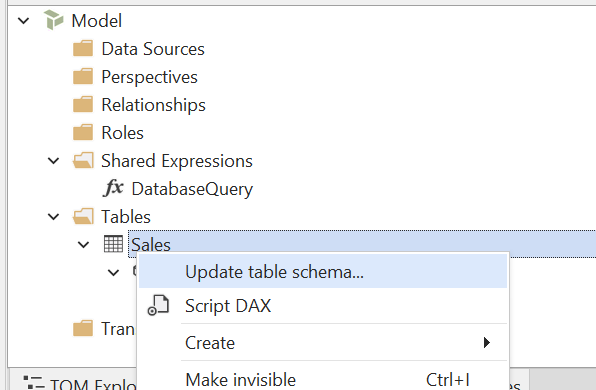
Alternatively, manually add Data Columns to the table (Alt+4) and specify the Name, Data Type, Source Column and any other relevant properties for each column.
Note
When a Direct Lake table is added to the model, it needs to be manually "refreshed" after the first metadata deployment. Otherwise, the table will not contain any data when queried. This refresh only needs to be performed once. Tabular Editor 3 will automatically refresh the table when the model metadata is saved, if the Auto-refresh when saving new tables under Tools > Preferences > Model Deployment > Data Refresh.
Direct Lake on SQL
To manually set up a table for Direct Lake on SQL mode, follow the steps in the section above for Direct Lake on OneLake, but use the following M query in the Shared Expression instead:
let
database = Sql.Database("<sql-endpoint>", "<warehouse/lakehouse name>")
in
database
Replace <sql-endpoint> with the connection string of the SQL Analytics Endpoint of the Fabric Warehouse or Lakehouse, and <warehouse/lakehouse name> with the name of the Warehouse or Lakehouse.
Import from Lakehouse / Warehouse
If you want to configure a table for Import mode while sourcing data from a Fabric Lakehouse or Warehouse, the steps are as follows:
- Create table: Create a new table in the model (Alt+5), then expand the table partitions in the TOM Explorer. By default, you should see a single partition of type "Import" created automatically:

- Configure Import Partition: Set the following M query on the Import Partition:
let
Source = Sql.Database("<sql-endpoint>","<warehouse/lakehouse name>"),
Data = Source{[Schema="<schema-name>",Item="<table/view-name>"]}[Data]
in
Data
Replace <sql-endpoint> with the connection string of the SQL Analytics Endpoint of the Fabric Warehouse or Lakehouse, and <warehouse/lakehouse name> with the name of the Warehouse or Lakehouse.
Replace <schema-name> with the schema name in the Warehouse/Lakehouse, and <table/view-name> with the name of the table or view you want to import. Note that tables in Import Mode can use non-materialized views as the data source, since the data is queried through the SQL endpoint during refresh operations.
- Update column metadata: Use Tabular Editor's Update Table Schema feature to update the column metadata for the table. This will automatically retrieve the column names and data types from the Lakehouse/Warehouse. Alternatively, create Data Columns manually (Alt+4) and specify the
Name,Data Type,Source Columnand any other relevant properties for each column.
Converting between storage modes
It is straightforward to convert between Direct Lake on SQL and Direct Lake on OneLake using the information in this article, because you only need to modify the M query of the Shared Expression referenced by the Direct Lake partitions.
If you want to convert from Import to Direct Lake it's slightly more complicated because of the different partition types involved.
To make things easier, we have prepared a set of C# scripts that can help you convert between different storage modes: